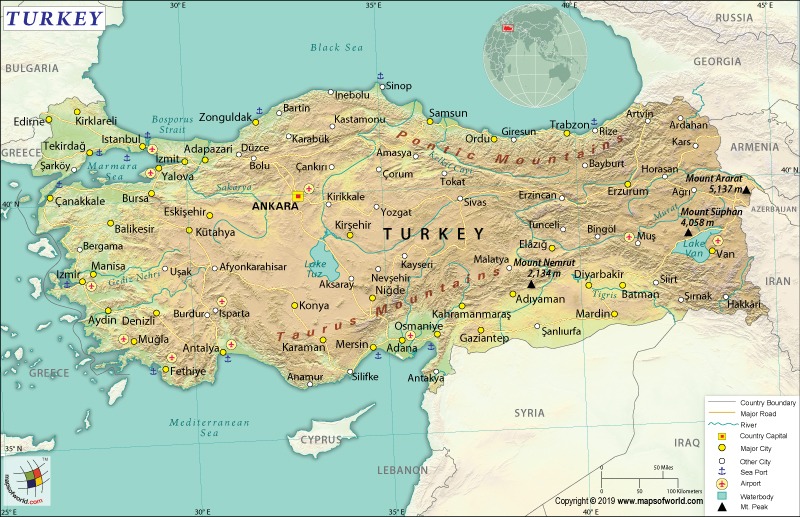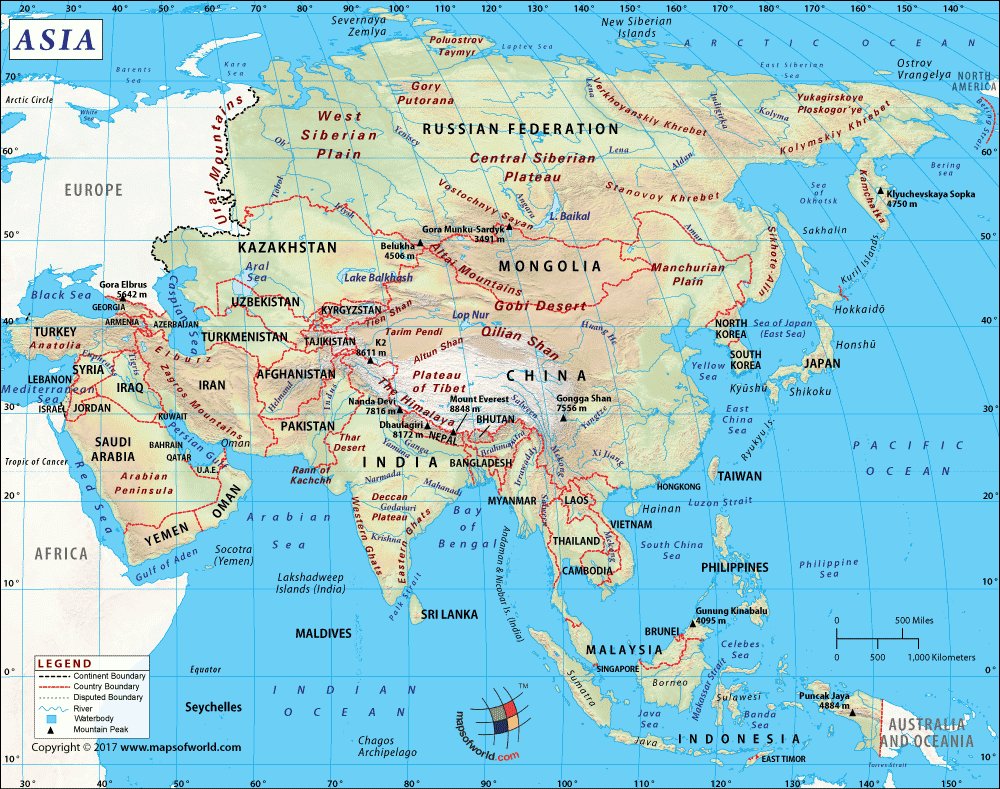What are the Key Facts of Turkey?

|
Official Name |
Republic of Turkey |
|
Continent |
Transcontinental (Europe & Asia) |
|
Capital |
Ankara |
|
Largest City |
Istanbul |
|
Coordinates |
39.000000, 35.000000 |
|
Area |
302,455 sq. mi (783,356 sq. km) |
|
Land Boundaries |
1,750 mi ( 2,816 km) |
|
Coastline |
4,474 mi ( 7,200 km) |
|
Currency |
Turkish lira (₺) (TRY) |
|
Neighboring Countries |
Syria, Iran, Greece, Iraq, Azerbaijan, Bulgaria, Georgia, Armenia |
|
Population |
82,003,882 (2018 est. ) |
|
Official Languages |
Turkish |
|
Major Religion |
Islam |
|
National Day |
29 October (Republic Day) |
|
National Anthem |
“Istiklal Marsi” |
|
Form of Government |
Unitary presidential constitutional republic |
|
President |
Recep Tayyip Erdoğan |
|
Vice-President |
Fuat Oktay |
|
GDP per capita (PPP) |
$ 27,892.5 (World Bank, 2018) |
|
GDP per capita (nominal) |
$ 9,311.4 (World Bank, 2018) |
|
HDI |
0.791 (2017), Rank: 64 |
|
Literacy Rate (%) |
96.15 (UNESCO, 2017) |
|
Space Agency |
Turkish Space Agency |
|
Military Expenditure Ranking |
14 (SIPRI, 2017) |
|
No. of Olympic Medals |
91 (as of 2018) |
|
Driving Side |
right |
|
Calling Code |
+90 |
|
Time Zone |
UTC+3 (FET) |
|
Internet TLD |
.tr |
Where is Turkey?
Turkey stretches from Southeastern Europe to Southwestern Asia. It borders the Black Sea and is located between Georgia and Bulgaria. The Republic of Turkey also borders the Mediterranean Sea as well as the Aegean Sea between Syria and Greece.
What is the Geography of Turkey?
The total area of Turkey is 783,356 sq. km (302,455 sq. mi), out of which 769,632 sq. km (297,157 sq. mi) is land area and 13,930 sq. km (5,378 sq. mi) is water area. It has a 2,816 km (1,750 mi) long land boundary, which is shared with 8 neighboring countries: Syria (899 km or 559 mi), Iran (534 km or 332 mi), Iraq (367 km or 228 mi), Armenia (311 km or 193 mi), Georgia (273 km or 170 mi), Bulgaria (223 km or 139 mi), Greece (192 km or 119 mi), and Azerbaijan (17 km or 11 mi). Turkey has a 7,200 km (4,474 mi) long coastline.
Turkey has a wide array of landforms, thanks to its geographical location. It connects Europe with Asia Minor. While the European part of Turkey is known as Anatolia, the European part is known as Thrace. The Anatolian Plateau occupies most of the interior regions. This plateau is bordered by Taurus, Pontic, and Koroglu mountains as well as the eastern highlands.
While the Black Sea region is situated in the northern peripheral region of Turkey, the Aegean region is located in the far western parts. The Fertile Crescent and Mediterranean region is situated in the southeast and southwest periphery of Turkey.
Mount Ararat is the highest elevation point of Turkey at 5,137 m (16,854 ft), and the Mediterranean Sea at 0 m (0 ft) is the lowest elevation point. The mean elevation is 1,132 m (3,714 ft). The major mountains in the country are Buyuk Agrı (Greater Ararat), Kucuk Agri (Lesser Ararat), Gelyansin, Kackar Dagi, Suphan, etc.
The Anatolian plateau rises from around 1,900 ft (579 m) to 3,900 ft (1,189 m) in the eastward direction. Many river valleys and basins (including Tuz Gölü and Konya Ovasi) break the plateau. The Koroglu Mountains are located in the north, running parallel to the Black Sea.
The Pontic range dominates the northern part. Along the southern coast, the Taurus range is located. It rises from the Mediterranean Sea and moves eastward, curving to converge with the Pontic range. That’s how the Anti-Taurus region is formed. This region houses many extinct volcanoes, the largest lake of the country Lake Van, and many rivers including Euphrates, Tigris, and the Aras River.
Around the Tigris and Euphrates rivers, the flatter southeastern strip of Turkey is formed. It is known as the Fertile Crescent. As it runs towards the Adana city, the landform is dotted with collapsed limestone caverns as well as sinkholes. The coastline in the northern parts of the country is steep as well as rocky. The rivers fall from the mountains to the sea. Some of the major rivers in Turkey are Euphrates, Tigris, Murat, Sakarya, Aras, Kizilirmak (Halys), Kura, etc.
A significant variation is witnessed in the climatic conditions in different parts of Turkey. Due to the difference in exposure to coasts and slopes, some microclimates are also found in Turkey. A mild climate is witnessed along with the coastal areas. However, the temperature along the Black Sea coast is colder than the Mediterranean Sea.
Continental climate is found in the interior parts of the country. It is characterized by cold and snowy winters as well as hot and dry summers (except for the north-east coast). The night time remains cool even during summer. The driest months in the inland and south-central regions are July, August, and September.
What is the Economy of Turkey?
The economy of Turkey is one of the top-20 largest economies in the world, in terms of nominal GDP. The nominal GDP of the economy was US$ 766.509 billion, and it grew at 2.567%. in 2018.
The main exports of the country are gold, cars, jewellery, vehicle parts, delivery trucks, and many more. The main import items are refined petroleum, scrap iron, cars, gold, vehicle parts, etc. Turkey imports more valued goods than its exports, resulting in a negative balance of trade. In 2017, the balance of trade was – $48.6 billion as the export amount was $166 billion, and the import amount was US$214 billion.
During December 2018 and February 2019, the unemployment rate in Turkey has jumped to 14.7% to a whopping 4.67 million. The rate of poverty in Turkey was 9.90% in 2016, around 13% less than 23.2% in 2009.
What is the Transportation System of Turkey?
Turkey has 67,333 km (41,839 mi) long roadway, out of which 24,082 km (14,964 mi) is paved and 43,251 km (26,875 mi) is unpaved. Out of the total paved roads, 2,159 km (1,342 mi) is expressways. 12,710 km (7,898 mi) long railway network is also there, out of which 11,497 km (7,144 mi) is standard-gauge. 1,200 km (746 mi) of waterways are also available in Turkey. The major seaports are Aliaga, Yarimca, Ambarli, Limani, Diliskelesi, Mersin (Icel), Eregli, Kocaeli (Izmit), and Izmir. One thousand two hundred seventy-seven merchant marine ships are there. There are 98 airports in Turkey, out of which 91 have paved runways, and 7 have unpaved runways.
What International Organizations is Turkey part of?
UN, WTO, IMF, ILO, NATO, NSG, UNESCO, Australia Group, BIS, BSEC, CD, CE, D-8, EAPC, EBRD, ECO, FAO, FATF, G-20, IAEA, IBRD, ICAO, ICRM, IDA, IDB, IEA, IFAD, IFC, IFRCS, IHO, IMO, IMSO, Interpol, IOC, IOM, IPU, ISO, ITSO, ITU, MIGA, NEA, OECD, OIC, OPCW, OSCE, PCA, SELEC, UNCTAD, UNHCR, UNIDO, UNIFIL, UNRWA, UNWTO, UPU, WCO, WHO, WIPO, WMO, ZC, ADB (nonregional member), CERN (observer), CICA, PIF (partner), CPLP (associate observer), CBSS (observer), EU (candidate country), ICC (national committees), ITUC (NGOs), OAS (observer), Pacific Alliance (observer), Paris Club (associate), SCO (dialogue member), WFTU (NGOs)
Related Links:



